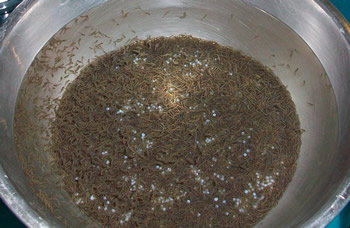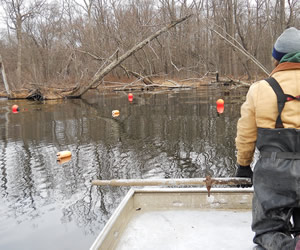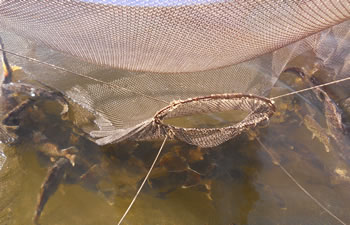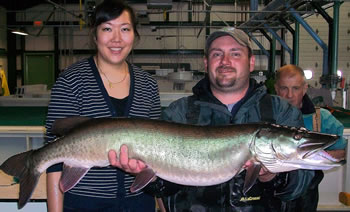by Craig Lemon
Hatchery Superintendent
July 16, 2013
The 2013 spring trapnetting season kicked off the second week of March just as it has many times before. With the ice melted off of Budd Lake, the hatchery crew set 3 trapnets on March 12th. The two South Dakota-style nets and one Pennsylvania-style net were set along the shore to capture northern pike broodfish to transport back to the hatchery for spawning.
The nets were fished from March 12th through March 17th capturing a total of 164 pike in 5 days compared to 114 in 10 days of fishing in 2012. The 164 pike in 5 days of netting equals 33 pike per day, the 2nd highest total (first was 41 pike per day in 1999) the hatchery crew has captured since trapnetting began in 1996. This year's catch consisted of 115 males and 49 females. Budd Lake water temperatures ranged from 34 - 42 degrees. The Budd nets also captured good numbers of the following species: white perch (3,450); black crappie (1,725); sunfish (671); and yellow perch (376). Eleven other species of fish were captured including 11 largemouth bass, 34 chain pickerel and two smallmouth bass.
|
The male pike averaged 3.2 pounds and 24.4 inches, ranging from 0.6-5.88 pounds and 14-30 inches long. The females averaged 4.54 pounds and 26.3 inches long, ranging from 0.62-9.05 pounds and 14.5-32.6 inches long. Of the 49 females, 5 arrived at the hatchery ripe, 34 ripened and were spawned while at the hatchery and only 3 came in spent compared to 15 spent in 2012. The 34 females produced 880,000 northern pike eggs, and 270,000 eggs for tiger muskellunge, averaging about 33,825 eggs per female. The hatch rate was 56%.
Pike eggs hatch in 10 days and the fry swim up looking to feed in another 5 days. By the posting of this article, the pike will have grown to their targeted size of 6 - 7 inches, and 40,000 will be stocked in 9 different lakes and rivers. (See the Hackettstown Stocking Summaries for detais.)
|
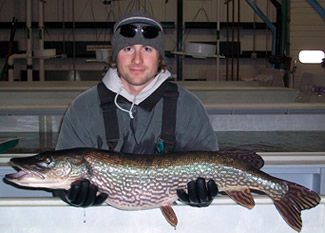 Senior Fisheries Worker Ryan Votta showing off a nice Budd Lake northern pike.
Senior Fisheries Worker Ryan Votta showing off a nice Budd Lake northern pike.
Click to enlarge |
Having collected enough northern pike eggs, the crew would normally pick up the netting gear and head north to Sussex County's Swartswood Lake in search of walleye broodfish. Watching the weather, staff let a couple of cold fronts pass through before taking a boat out on Swartswood Lake on March 22nd. They removed debris resulting from Sandy and the winter from the mouth of Neldon Brook where nets would be set.
|
|
With water temps still hovering at 39-40 degrees, staff had waited long enough and on March 26th set a Pennsylvania-style trapnet with some modified wings in the mouth of Neldon Brook and a second Dakota-style trapnet off a nearby rocky point.
The nets were fished for 3 days capturing 292 walleyes. The catch was made up of 216 males and 77 females. Swartswood's water temperatures ranged from 39-43 degrees. The nets captured nine other species, but in very low numbers. This could be attributed to the fact that the walleyes are migrating from different sections of the lake towards Neldon Brook to run up and spawn, while the cool water temps are keeping many of the other species movements down.
|
The male walleyes averaged 2.84 pounds and 19.5 inches, ranging in weight from 1.1 to 4.8 pounds, and in length from 15 to 23.4 inches. The females averaged 4.65 pounds and 22.1 inches, ranging from 2.3 to 9.9 pounds, and 17.5 to 28.5 inches. The netting crew once again hit the peak of the spawning season as 70 of the 77 (91%) females captured were spawned. The 70 females yielded 6.4 millions eggs, averaging about 94,405 eggs per fish. The eggs hatched at a rate of 51%. The crew set up 500,000 two-day old fry into 3 large hatchery ponds for growout and another couple million fry were stocked in the Delaware River from Milford, PA to Belvidere, NJ. The expected hatchery pond production of walleye fingerlings is about 100,000 two-inch and 35,000 four-inch fish.
|
Normally the netting crew would quickly switch gears and get right into muskellunge trapnetting on Greenwood Lake, but lake water temperatures continued to hover in the low 40s. The crew made the decision to keep the boat warm and dry back at the hatchery and give themselves time to work on newly hatched northern pike fry. On April 8th, knowing we couldn't wait any longer, the crew loaded the boat and a pickup full of nets and headed north to Greenwood Lake and Echo Lake Reservoir in search of the "Fish of 1,000 Casts," the Muskellunge.
Normally, the hatchery would split these lakes up, setting Greenwood first, followed by Echo Lake, a week later. With water temps closing in quickly on the magic 50-degree mark, it was decided to fish both at once. Every year adult muskies move onto their traditional spawning grounds in mid-April when waters near 50 degrees. Staff set Pennsylvania-style trapnets on the very shallow southern end of Greenwood Lake near the mouth of Belcher's Creek.
|
|
The 56-degree water and strategically placed nets produced 15 muskies on the first day, more than half the 10-day total. During the ten-day netting period from April 8-April 18, the crew captured 29 adult muskies. The Greenwood catch was a bit lopsided at 9 males and 20 females. The males averaged 12.9 pounds and 36.4 inches, ranging from 7.82 to 18.9 pounds and from 30.2 to 41.6 inches. The females averaged 17.9 pounds and 40.3 inches and ranged from 5.8 to 26.06 pounds and from 26.5 to 47.2 inches.
|
|
Also beginning April 8th, the hatchery crew set one Pennsylvania-style trapnet in the North Cove and one South Dakota-style trapnet in the South Cove of Echo Lake Reservoir. The two nets were fished through April 19th, capturing just 7 muskies, compared to the 19 muskies captured in 16 days netting in 2012.
The Echo Lake Reservoir catch was also lopsided with all seven fish females. They averaged 22.3 pounds and 43.9 inches ranging from 9.26 to 27.56 pounds and from 33.9 to 47.2 inches. Of the 7 females captured, 5 of them were spawned producing 410,000 eggs, about 82,000 per female. The nets also caught 14 other of non-target species such as alewives and shiners, sunfish, crappies, yellow perch, and largemouth and smallmouth bass. Water temperatures ranged from 46-54 degrees.
|
Between the two lakes, a total of 24 female muskies were spawned producing about 2 million eggs. The eggs hatched at a rate of 31%, which is below average. The 630,000 fry then went through a 7-10 period where they were feeding off their yolk sacs. They are then called swimup fry as they lift off the tank bottom and begin free swimming. Hatchery workers are beginning our toughest month when we attempt to convert a high percentage of muskie fry onto dry pelleted diets. This conversion period consists of cooking brine shrimp during a two to three week period and feeding the shrimp 4 times per day to swimup muskie fry. This is necessary as they instinctively will eat a moving food source as opposed to the dry feed just slowly dropping straight down through the water column.
|
The tiny fry are fed 14 days of cooked brine shrimp, each day mixing in more dry feed, weaning the fry off of the shrimp at the end of the two week period. As the fry are growing the feed particle size is raised every couple of days, as the fish go for the larger pellets as soon as they are introduced. This aids in reducing the natural cannibalism which exists in nature. By this time we hope that a high percentage (80%+) will have taken to the dry food diet.
The muskie fry are raised both indoors in hatchery tanks and outdoors in earthen ponds. The target number is 12,000 ten-inch fingerlings. They are currently three to four inches in length and should reach stocking size by October 15th in time to be float stocked into lakes, rivers and reservoirs.
For the 6th straight season the Hackettstown Hatchery received a request from the NY Department of Environmental Conservation's South Otselic Fish Hatchery to provide them with 100,000 tiger muskellunge fry. Hatchery staff were successful in providing them with these fry. In early April, NY hatchery personnel picked up 130,000 female northern pike x male muskellunge hybrid tigers. Hackettstown staff used 40 male northern pike with 7 female muskies to produce the 130,000 tiger fry.
|
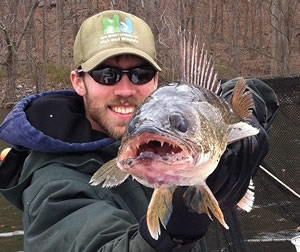 Senior Fisheries Worker Nick Healy with nice Greenwood Lake walleye.
Senior Fisheries Worker Nick Healy with nice Greenwood Lake walleye.
Click to enlarge |
Over the winter, we also received requests from the Connecticut Division of Fish and Wildlife for 100,000 swimup northern pike fry and from the Massachusetts Division of Fisheries and Wildlife for any surplus northern pike fingerlings we might have. On April 2nd, two Connecticut Fisheries biologists made the trip to Hackettstown and left with 135,000 swimup northern pike fry that they were going to stock in a couple of breeding marshes to see how they would grow. On April 23, two Massachusetts Fisheries Biologists made the trip down and picked up 20,300, 2.5-inch fingerling northern pike to be stocked in a large inland lake. They made a second trip down for 6,426 surplus northern pike averaging 5.2 inches on May 21.
The Hackettstown Hatchery also provided the PA Fish and Boat Commission's Pleasant Mount Fish Culture Station with 75,000 swimup tiger muskellunge fry and 63,580 swimup muskellunge fry. All of these fish are provided at no charge to our neighbors as part of an ongoing fish exchange that has been in place for many years. Most of our cool and warm water programs started in New Jersey with eggs and fry from Pennsylvania and New York. State pathologists sample all of these fish before transport to ensure they are free of disease.
|
|
All broodstock collected for use in the hatchery programs were transported to the hatchery where the egg taking operations are performed by hatchery personnel. Within a week of spawning the fish are returned to the waters where they were collected.
All adult muskies handled at the hatchery over the past seven years have been tagged with orange streamer tags inserted near the base of the dorsal fin. The tags bear the message "CALL HACKETTSTOWN HATCHERY (908) 852-4950" along with a tag number. Anglers who call in to report catching a tagged fish will be told when the fish was tagged, and its length and weight at the time of tagging.
The purpose of the Hackettstown Hatchery's broodstock program is to provide the eggs from which fish are raised at the hatchery. All fish raised at the Hackettstown Hatchery are stocked in public waters throughout the state to provide recreational fishing for licensed anglers and their families.
|
In coordination with state fisheries biologists, the Hackettstown Hatchery is raising the following numbers of northern pike, muskellunge, tiger muskies, and walleyes to meet the state's needs for 2013:
24,520 northern pike fingerlings for stocking in:
Cranberry Lake (Sussex County); Pompton Lake and Pompton River (Passaic County); Spruce Run Reservoir (Hunterdon County); Budd Lake (Morris County); Farrington Lake (Middlesex County); Deal Lake (Monmouth County); Millstone River and the Passaic River.
11,111 muskellunge for stocking in:
Greenwood Lake, Monksville Reservoir and Echo Lake Reservoir (Passaic County); Lake Hopatcong (Morris and Sussex counties), D&R Canal 10-mile stretch (Somerset and Mercer Counties); Manasquan Reservoir (Monmouth County); Carnegie Lake and Mercer Lake (Mercer County); Mountain Lake and Furnace Lake (Warren County); Shenandoah Lake (Ocean County); Little Swartswood Lake (Sussex County); and DOD Lake (Salem County).
207,950 walleyes for stocking in:
Lake Hopatcong (Morris County), Swartswood Lake (Sussex County), Greenwood Lake (Passaic County), Canistear Reservoir (Sussex County), Monksville Reservoir (Passaic County) and the Delaware River (Sussex and Warren counties).
Below are summary tables of fish collected in spring, 2013.
NORTHERN
PIKE
| WATERBODY |
# DAYS NETS WERE SET |
# FISH CAUGHT |
AVERAGE LENGTH (INCHES) |
LARGEST FISH (INCHES) |
AVERAGE WEIGHT (POUNDS) |
LARGEST FISH (POUNDS) |
| BUDD LAKE |
5 |
164 |
25.0 |
32.6 |
3.61 |
9.05 |
MUSKELLUNGE
| WATERBODY |
# DAYS NETS WERE SET |
# FISH CAUGHT |
AVERAGE LENGTH (INCHES) |
LARGEST FISH (INCHES) |
AVERAGE WEIGHT (POUNDS) |
LARGEST FISH (POUNDS) |
| ECHO LAKE RESERVOIR |
11 |
7 |
43.9 |
47.2 |
22.3 |
27.56 |
| GREENWOOD LAKE |
10 |
29 |
39.1 |
47.2 |
16.3 |
26.06 |
WALLEYE
| WATERBODY |
# DAYS NETS WERE SET |
# FISH CAUGHT |
AVERAGE LENGTH (INCHES) |
LARGEST FISH (INCHES) |
AVERAGE WEIGHT (POUNDS) |
LARGEST FISH (POUNDS) |
| SWARTSWOOD LAKE |
3 |
292 |
20.2 |
28.5 |
3.31 |
9.9 |
The hatchery also raises 13 other species of fish for waters throughout the state - see the Hackettstown Hatchery Production and Stocking Summaries for details.
RELATED PAGES


